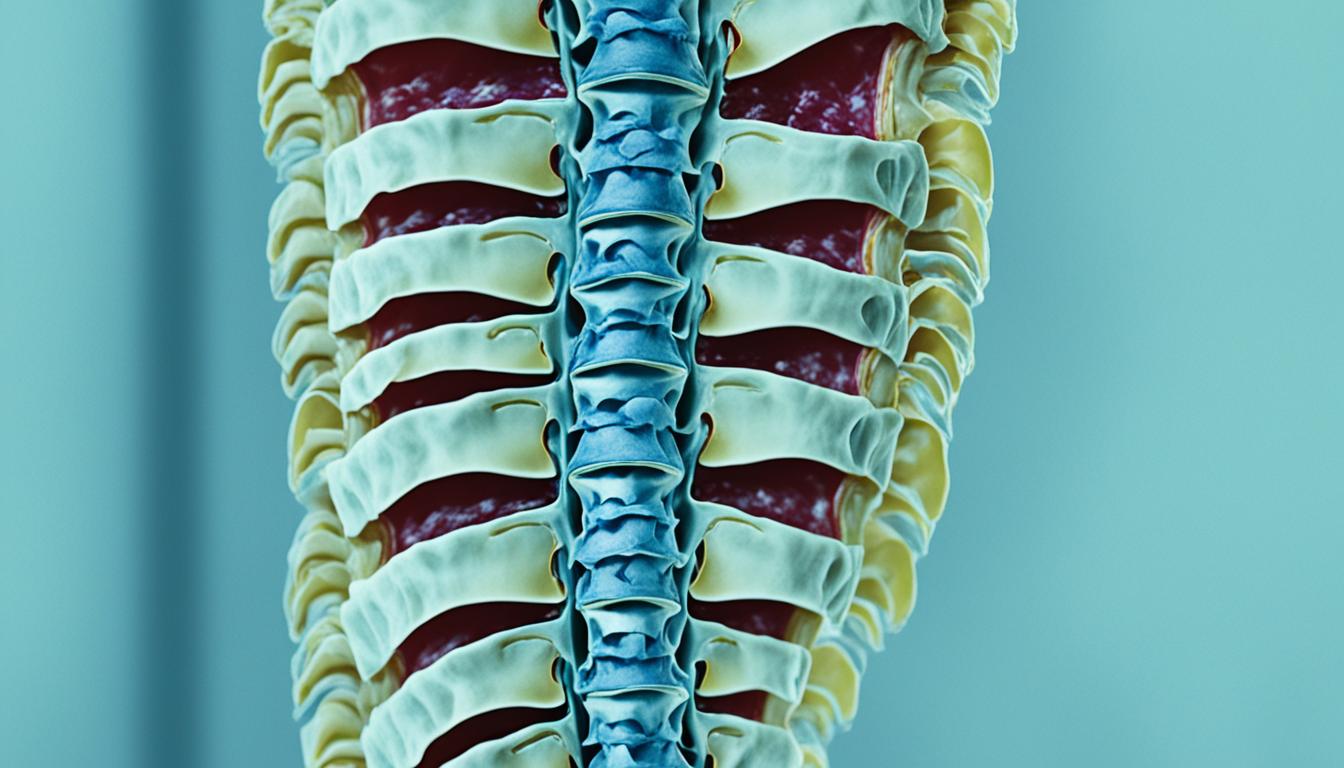Spinal stenosis is very common and affects the spine. This leads to pain and discomfort. The condition happens when open spaces in the spine narrow down. This puts pressure on the spinal cord and nerves. Two main types exist: one that affects the neck (cervical) and one that affects the lower back (lumbar).
Causes of spinal stenosis include arthritis, herniated discs, injuries, tumors, and thickened ligaments. It’s often seen in people over 50. The narrowing can cause symptoms like back pain, numbness, and weakness. In some cases, it can even lead to loss of control over bladder or bowel.
Doctors diagnose spinal stenosis with a physical exam and tests. They look at symptoms and might use X-rays, MRI scans, and CT scans. These tests show where and how severe the stenosis is.
Treatment depends on how severe it is and how it affects a person’s life. Non-surgical options include physical therapy, pain medication, and spinal injections. Supportive devices can also help.
In severe cases, surgery might be needed to make more space in the spine. This can relieve pressure on the nerves. But, it’s important to try other treatments first.
Stem cell therapy is new and being researched for treating spinal stenosis. There’s hope it could help, but more research is needed to know for sure.
Key Takeaways:
- Spinal stenosis is characterized by the narrowing of the open spaces in the spine, putting pressure on the spinal cord and nerves.
- There are two main types of spinal stenosis: cervical and lumbar.
- The condition can be caused by factors such as arthritis, herniated discs, injuries, tumors, and thickened ligaments.
- Common symptoms include back pain, numbness, tingling, weakness, and loss of bladder or bowel control.
- Diagnosis involves physical exams and imaging tests to determine the location and severity of the condition.
- Treatment options include physical therapy, medication, spinal injections, and surgery.
- Stem cell therapy is being researched for its potential in treating spinal stenosis.
Causes and Risk Factors of Spinal Stenosis
Spinal stenosis happens when the spaces in your spine get smaller. It can occur due to many reasons. Knowing these reasons helps find the best treatments.
Arthritis
Arthritis is a common cause. It wears down cartilage and makes bone spurs. This can narrow the spinal canal. Thickened ligaments can also cause pressure on the spinal cord and nerves.
Herniated Discs
Herniated discs are another cause. When a disc bulges, it can press on nerves. This pressure can lead to spinal canal narrowing.
Injuries and Tumors
Spine injuries like fractures can also induce spinal stenosis. Tumors in the spinal canal can press on nerves. This pressure causes stenosis.
Age and Other Risk Factors
Spinal stenosis is often found in those over 50. Aging causes the spine to wear down, narrowing the canal. Women and people with specific medical histories are more likely to get it.
Youth can also be affected by spinal injuries or conditions from birth.
To treat spinal stenosis well, the main causes and risks must be found. Personalized treatments focusing on these can lessen symptoms. This leads to a better life quality.
Symptoms and Diagnosis of Spinal Stenosis
The symptoms of spinal stenosis change depending on where and how severe the narrowing is. Knowing these symptoms is key. It helps find the right diagnosis and treatment.
Common Symptoms
- People with spinal stenosis often feel pain, which can be from mild to severe. This pain might only be in their back or neck. It could also go down their arms or legs.
- Feeling numb or losing sensation in an area is common with this condition.
- There might be tingling, like pins and needles in the arms, legs, hands, or feet.
- Muscle weakness can also happen, making daily tasks hard to do.
- If someone loses control of their bladder or bowel, they need to seek help right away.
If any of these symptoms sound familiar, see a doctor for a proper check-up.
Diagnosis
Diagnosing spinal stenosis requires a detailed process, including:
- First, the doctor will ask about your medical history. They will look at your symptoms, past injuries, and family health.
- Then, a physical exam is done to check your strength, flexibility, and reflexes. Nerve function may also be tested.
- Imaging tests like X-rays, MRIs, and CT scans help confirm the diagnosis. They show where and how bad the narrowing is.
After these steps, the doctor will have a clear diagnosis. They can then suggest the right treatment for you.
If you think you might have spinal stenosis, don’t wait to get help. Finding it early and getting treatment can slow down the condition. This can make a big difference in your life quality.
Treatments for Spinal Stenosis
Treating spinal stenosis depends on how bad it is and where it’s located. Often, doctors try treatments that don’t need surgery first. Physical therapy is key for getting stronger and more flexible. This can ease pain and make it easier to move.
Doctors might also prescribe medications to help with pain and swelling. They can make the discomfort more bearable.
If simple treatments don’t work, surgery might be the next step. There are different surgeries for spinal stenosis. These include making more room in the spine. This can take pressure off nerves and lessen the symptoms.
Exploring stem cell therapy for spinal stenosis is still ongoing. Scientists are studying how stem cells might help the spine heal. While there’s hope from early research, more studies are necessary to confirm if and how well it works.

